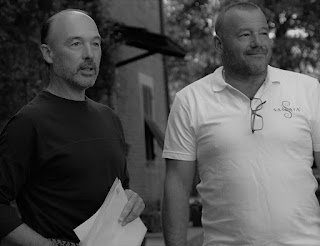Saturday, June 26, 2021
Colli Tortonesi DOC's Terre di Libarna subzone
Thursday, June 24, 2021
Navigating the waves of a post-modern Timorasso environment
Initial Vintage | Producer | Producer Origins | Timorasso Holdings | Source(s) of Purchased Fruit |
2007 | Cascina La Ghersa | Moasca | Casasco and Sarezzano; 1.8 ha | |
2013 | Fontanassa | Gavi | ? | ? |
2014 | Roagna | Barbaresco | Montemarzino; 1 ha | |
2015 | Borgogno | Barolo | Monleale; 3 ha | |
Cascina Gentile | Capriata d’Orba | ? | ? | |
2018 | Broglia | Gavi | Costa Vescovata | |
Sassai | Capriata d’Orba | Profigate and Ca’ del Borgo; 5 ha | Castellania and Monleale | |
Vietti | Barolo | Monleale; 4.1 ha | ||
2019 | La Spinetta | Asti | Montegioco, Monleale, and Montemarzino; 5 ha | |
Monilia | Barolo | Monleale; 1.5 ha | Monleale | |
Reis | Langhe and Monferrato | Sarezzano | ||
N/A | Alvio Pestarino | Capriata d’Orba | Stazzano; ? | |
Pio Cesare | Alba | ?; 2.5 ha | Vho | |
Voerzio Martini | La Morra | ? |
- They are impressed by the work of Massa and his disciples
- They understand the greatness of Timorasso
- They want to expand the the range of their reds with an important white
- Vineyards are a bargain in Colli Tortonesi when compared to the sky-high costs in Barolo and its surrounds.
- Vietti was impressed with the characteristics and future outlook of Timorasso
- Pietro Oddero thinks that Timorasso "is the most interesting indigenous white variety in Italy."
- The Reis team decided to do a project as a group and wanted it to be something challenging. Given cost and availability constraints, it most likely could not be in Barolo. The Timorasso venture is a testament to the friendship as well as the potential of the variety.
- Walter Massa saw these entrants as advantageous because of their perceived ability to market Timorasso in foreign markets
- Conrad Mattern, a distributor of Timorasso wines in Germany, "senses mixed feelings among the "locals"as regards the new, high profile entrants... They like what these big-name producers can do in terms of marketing Timorasso but, on the other hand, these are large producers and are accompanied by a 'smidgen' of industrialization.
- Gian Paolo Repetto, head of the Consorzio, and Proprietor of Vigneti Repetto, feels that these entrants have been a "blessing" in that they have raised the profile of the region
- Marco Volpi of Cantine Volpi is supportive of those who come in and buy vines and gives a nod of approval to the Barolo producers in this regard. "Those who come into the region and invest are making a positive contribution and should be encouraged."
Thursday, June 17, 2021
Assyrtiko, Carricante, and Timorasso: Three peas in a pod?
- A distinctive taste of rocks and salt
- Tight and firm in its youth with stone or tropical fruit aromas, depending on the ripeness, along with the telltale rocky saltiness.
- Vertical and powerful on the palate with the unique combination of high alcohol (up to 15.5% abv) and high acidity (pH can be as low as 2.8 and TA as high as 7.5 g/l).
 |
| Source: Winesfromsantorini.com |
Santorini vines are, for the most part, in excess of 50 years old. Vines are retained until the yield is almost zero or when the vine dies. When the vine is no longer productive, it is replaced by a branch from a nearby vine which is buried to a depth of 30 cm into the soil. After that branch has developed its own roots and has begun producing berries (a period of between 3-5 years) it is cut away from the tethering parent.
Wine Styles
- Classic -- taut; made from 100% Assyrtiko
- Blended with Athiri and/or Aidani; wines are broader and softer
- Lees aging
- Few months to two years on lees
- Fills out the mid-palate and balances the bright acidity
- Can add more complexity
- Oak -- best examples display a creamy, toasty complexity.
This section draws from my original research, email exchanges with Benjamin North Spencer and Brandon Tokash, and Benjamin’s book The New Wines of Mount Etna.
 |
| Carricante (tenutaterrenere.com) |
The variety (The New Wines of Mt Etna):
- Is the result of a natural crossing between Montonico Pinto and Scacco
- Is the primary white wine grape variety on Mt Etna
- Produces pale yellow wines with beautiful freshness and savory flavors
- Is most often blended with Catarratto, Minella Bianca, and non-aromatic Sicilian varieties to create sophisticated still table wines with great aging potential
- Is productive, but when grown above 400 m, the loading decreases and the quality improves
- Exhibits a slight petrol or kerosene scent in some wines
- Produces its best examples in the Milo area of Mt Etna.
There is a saltiness in the east side Carricante that is lacking in wines made from grapes grown on the north side of the mountain.
As is the case for the Santorini Assyrtikos, Carricante-based wines from the east to south flanks of Etna are characterized by salinity, minerality, and acidity and, at optimum, these characteristics meld extremely well. These characteristics also allow the wines to age well (based on my experiences drinking aged Benanti Pietra Marina wines). While the characteristics of the wines are consistent, the quality of individual wines will vary based on winemaking practices, elevation, soil composition, and other related factors.
As shown on the below chart, growing conditions in the east and southeast differs from the conditions in the north and southwest.
 |
| Derived from Nesto and di Savino |
The southeast and eastern slopes are unprotected from the autumn and winter rains but the combination of rapid runoff and early morning sun contribute to their attractiveness as growing regions (especially for whites).
The volcano's southeast flank experiences markedly different climatic conditions than north-slope-resident wineries. First, it is warmer in the southeast than in the north; 4 to 7 degrees warmer, as a matter of fact.
Second, with no protective layer of mountains, the region bears the full brunt of the wind and rain coming in off the Ionian Sea. In the fall and spring, dry winds form over North Africa, pick up moisture over the Mediterranean, and barrel into the Sicilian coast at upwards of 50 miles an hour. These winds are called Scirocco and an event can last from 1/2 day to several days. The wind makes it easier to farm organically as it helps to keep mold at bay.
Third, the southeast is unprotected from the autumn and winter rains but the combination of rapid runoff and early morning sun contribute to its attractiveness as a growing region 9especially for whites).
- Etna DOC Bianco -- to be made from Carricante (> 60%), Catarratto (< 40%), and up to 15% of other non-aromatic grapes such as Minella or Trebbiano
- Etna DOC Bianco Superiore -- to be made from Carricante (> 80%) and Catarratto or Minnella (< 20%). All grapes to be sourced exclusively from the area of Milo on the eastern side of the volcano.
"Timorasso is a native grape variety of the province of Alessandria, with a quality white-berried grape, grown essentially in the Curone, Grue, Ossona, and Val Borbera valleys, in an area where the vine finds a valid 'habitat' thanks to the soil, sunshine and the position sheltered from the winds" (Consorzio).
- It is a difficult variety to grow
- Material sticks to the equipment during pruning and have to be constantly cleaned off
- Double and triple buds at bud break; these have to be cleaned out manually
- The short distance between buds are a disease risk
- Sunburn is an ever-present risk.
When young, Vigneti Massa's full-bodied Timorasso wines boast alluring floral scents, creamy apricot and apple flavors, and bright acidity. As they age, they gain in mineral complexity and boast dried fruit, almond and honeyed notes seamlessly balanced with fresh acidity. I've tasted numerous vintages over the years, and the wines evolve beautifully for at least fifteen years. As the vines get older, these superb whites may increase their aging potential.
- These wines have similar profiles as it relates to salinity, acidity, and minerality but Timorasso is more aromatic and structured than either the Assyrtiko or Carricante
- The Timorasso and Assyrtiko present a higher alcohol profile than does the Carricante
- Both the Timorasso and Carricante exhibit petrol notes with age
- The use of oak is much more advanced in Santorini than in Etna Bianco Superiore or Timorasso but Timorasso has the stuffing to handle oak well
- Surprisingly low levels of malolactic fermentation across the three environments
- Volcanic soils in Santorini and Mt Etna; Calcareous clay dominant in Colli Tortonesi.
- Low rainfall levels in Colli Tortonesi and on Santorini; significant rainfall on the east flank of Mt Etna.
- Relatively stressed vines in each location
- Strong winds from sea in all three locations.
Saturday, June 12, 2021
Sassaia (Capriata d'Orba, Alessandria, Piemonte): A sophisticated Timorasso startup
Table 1. Varieties planted at Sassaia vineyards.
Grape | Variety | Planted Hectares | Percent |
Reds | Nebbiolo | 2.5 | 42 |
Dolcetto | 2 | 33 | |
Cabernet Sauvignon | 0.7 | 12 | |
Sangiovese | 0.5 | 8 | |
Syrah | 0.3 | 5 | |
Total Reds | 6 | 100 | |
Whites | Gavi | 6 | 50 |
Timorasso | 5 | 42 | |
Chardonnay | 1 | 8 | |
Total Whites | 12 | 100 |

















